Petzl Grigri® +
Availability: NZ stock Dispatch: 1-2 working days
NZ Stock items are dispatched either from our own warehouses or directly from our key suppliers. The dispatch time indicates the expected period for your order to be processed, including picking and packing.
 Shipping
more info...
Shipping
more info...
Petzl Grigri® + - Orange is backordered and will ship as soon as it is back in stock.
Description
Description
The Petzl Grigri® + is a belay device designed for learning and top rope climbing, featuring cam-assisted blocking and an anti-panic handle. It is suitable for both indoor and outdoor use and can accommodate single ropes with a diameter of 8.5 to 11 mm. Its specific mode allows for easier slack management, making it an ideal choice for top rope climbing. Additionally, it is reinforced for intensive use and offers numerous features for a better belay experience.
Features
Belay device with cam-assisted blocking for learning, top roping, and intensive use:
- Designed for belaying both lead and top rope climbers.
- Specifically optimised for top rope climbing, featuring a lockable selector knob that allows the selection of top rope belay mode. This function simplifies slack retrieval and enhances comfort during belaying.
- Constructed with a stainless steel wear plate, ensuring exceptional durability for frequent and intensive use.
- Incorporates cam-assisted blocking for improved belay comfort. When the climber falls or puts weight on the system, the rope tightens, prompting the cam to pivot and securely pinch the rope.
Easy to use:
- Features an intuitive rope installation process, with a clearly engraved diagram on the device for guidance.
- Enables seamless slack feeding and fall-catching using standard Petzl belay techniques, always requiring the brake-side hand to remain on the rope.
- The cam-assisted blocking system provides flexibility in brake-hand positioning, regardless of the angle between the climber's side and the brake side of the rope.
- Compatible with dynamic single ropes ranging from 8.5 to 11 mm in diameter, with optimal performance for ropes between 8.9 and 10.5 mm.
Descent control:
- Equipped with an ergonomic handle, allowing for effortless rope unblocking and controlled lowering of the climber.
- Utilises a 3:1 mechanical advantage through the handle and camming mechanism, minimising effort while ensuring smooth descent control across various rope diameters.
- Features an anti-panic handle, which automatically engages to halt the descent if excessive force is applied to the handle.
Specifications
| Weight | 200 g |
| Rope compatibility | 8.5 to 11 mm single rope |
| Material(s) | Aluminum side plates, stainless steel friction plate, cam and wear plate, reinforced nylon handle |
| Certification(s) | CE EN 15151-1, UKCA, UIAA |
| Inner Pack Count | 1 |
Technology
Technical Notice
Declaration Of Conformity
- Download the PDF : UE-Declaration-D13A-Grigri-+ - 0.65 MB
- Download the PDF : UKCA-Declaration-D13A-GRIGRI-PLUS - 0.49 MB
Tips for maintaining your equipment
Inspection
PPE inspection procedure
PPE checklist
Technical Content
ASCENDING A ROPE WITH GRIGRI, GRIGRI + AND NEOX
|
WARNINGS
|
Ascending a rope is necessary in certain situations, for example if you descended too far on a rappel and need to go back up to reach the next rappel station. GRIGRI, GRIGRI + and NEOX can be used to ascend a rope, keeping the rope taut and taking up slack as you ascend.
WARNING: from the moment you stop, start, ascend, descend or even pendulum on a fixed rope, you make it all the more vulnerable to abrasion. Locate possible rub points on the rock as you descend, as this will tell you how much movement you can allow yourself in the event of a problem.
Note: the NEOX is less effective than the GRIGRI in this usage, due to the lag time in blocking (maximum one half rotation of the wheel) as described in the Instructions for Use. See also the technical tip: Normal sound of the NEOX.
If the rock is not too steep and allows you to stand on your feet:
Keep the brake side of the rope in your hand and take up slack as you ascend.

If you need to let go of the rope for your tasks (e.g. untangling the rope, making a belay), tie a knot in the brake side of the rope (see technical tip: Hands-free position with GRIGRI and NEOX).
Note: In any case, you must not let go of the brake side of the rope and climb. Self-belayed climbing is not allowed with the GRIGRI, GRIGRI + or NEOX.
Below an overhang or in any situation without support for the feet:
Use an ascender (e.g. TIBLOC, BASIC or even a Prusik) on the rope, and a sling to stand up in.
|
1. Tie a knot in the brake side of the rope to have your hands free to install the ascending system.
2. Install an ascender above your descender. Pass the brake side of the rope through the carabiner on this ascender to create a self-hauling effect. Install a sling as a footloop. 3. Pull on the brake side of the rope at the same time as you stand up in the footloop: tension on the descender is maintained at all times, with the rope taut between you and the top anchor. Hold the brake side of the rope throughout the maneuver. Note: If your available equipment allows it, it may be worthwhile to tether yourself to the ascender. This helps prevent losing it during operations and placing it out of reach in the event of user error. (The diagram does not show this lanyard for the sake of clarity). |
BELAYING A SECOND FROM ABOVE WITH GRIGRI, GRIGRI + AND NEOX
GRIGRI, GRIGRI + and NEOX can be used for belaying the second from the belay station on multi-pitch routes.
Two techniques may be used: belaying with the device on the anchor, or belaying with the device on the harness with the rope redirected. In both cases, the rope must be installed in the device in the same way, respecting the marking indicating the climber side of the rope. The belayer must never let go of the brake side of the rope.
|
Advantages:
Disadvantages:
|
Advantages:
Disadvantages:
|
Take care to avoid any blocking of the device or any pressure on the cam that could negate the braking action on the rope.
The belayer must continuously hold the brake side of the rope, even while the climber is stopped.
WARNING: With NEOX, but also with GRIGRI and GRIGRI +, on thin or new ropes, if the rope isn't held, it will slide through the device under its own weight, creating dangerous slack for the climber. This can happen more easily when belaying with the device on the anchor.
If the belayer needs to have their hands free, a stopper knot can be tied in the brake side of the rope.
RAPPELLING WITH GRIGRI AND NEOX
GRIGRI and NEOX enable rappelling on a single rope: on a retrievable system with one strand blocked, or on a fixed rope.
Hold the brake side of the rope and gradually pull the release handle. The handle helps adjust the friction, but the descent is controlled by the hand gripping the brake side of the rope.
Rappelling can be done on EN 892 dynamic or EN 1891 low stretch rope of a compatible diameter indicated on the device.
| There are several ways to set up the rope for rappelling: they are described in the technical tip, Multi-pitch rappelling with a single rope. |
|
Bottom Belay for Beginners A bottom belay is possible for beginners rappelling with a GRIGRI or NEOX (as with many other descenders): pulling on the rope from below can slow or even stop the descent. The person performing this maneuver must pull by hand, without hanging on the rope. |
WARNING: A strong pull on the brake side of the rope can cause the GRIGRI or NEOX to unblock.
With NEOX, GRIGRI + from 2017 and on, and GRIGRI from 2019 and on, unblocking and a consequent fall can occur if the rope below the user is heavily loaded. Unblocking can occur if the rope is loaded with a weight equal to or greater than that of the person rappelling.
Examples of dangerous situations:
Rescue from below:
- The rescuer must not ascend the rope of a person who is stuck on rappel.
- Bottom belay: the person performing the belay must not hang on the rope.
Multiple people rappelling in sequence, with descenders pre-installed on the rope:
- If the person waiting in turn to rappel has their descender pre-installed on the rope, it can be inverted (and thus unblocked) by the weight of the person rappelling below them. So it will not be operational when the second person wants to start their rappel.
BELAYING MULTI-PITCH ROUTES ON SINGLE ROPE WITH A GRIGRI.
When climbing a difficult pitch, a single rope is more convenient and straightforward for the climber. For the belayer, using a GRIGRI is also more convenient if the leader needs to work certain sections.
While Climbing
1. BELAYING THE LEADER DYNAMICALLY
With the GRIGRI, the movement of the belayer enables dynamic belaying. On a multi-pitch route, this movement is limited by the risk of hitting the belay station. A long tether gives the belayer room to move.
2. BELAYING THE SECOND
With a REVERSO:
- The leader can climb light with a REVERSO, which is convenient for belaying the second.
With a GRIGRI:
- Pay attention to the position of the GRIGRI: any blockage of the device or its cam will negate the braking action on the rope. To do this, see the technical advice on belaying a second with the GRIGRI.

|
Advantages and disadvantages of single rope for multi-pitch climbing, compared to half ropes. Am i making the right choice?
|
|
Advantages
|
Risks
|
| All these points must be taken into account to enable the rope team to select the right equipment for the planned route. The use of single rope on multi-pitch routes should be reserved for experienced climbers looking to work difficult pitches. |
USING THE GRIGRI/GRIGRI + WITH A LOW STRETCH KERNMANTEL ROPE
GRIGRI and GRIGRI + may be used with a low stretch kernmantel rope, with certain limitations on use:
| Observe the recommended rope diameter range (8.5 to 11 mm) | |
| Usage limited to top-rope belaying only. Warning: be sure to correctly identify low stretch kernmantel ropes to avoid any risk of confusion with a dynamic rope. | |
| Ensure you keep the rope taut between the climber and the belayer. |
TRIGGERING THE ANTI-PANIC HANDLE
Working Principle
The GRIGRI + has an anti-panic handle that is especially useful in learning how to control a lower.
If the belayer pulls too hard on the handle, the anti-panic mechanism triggers and stops the descent.
To continue the descent, the belayer releases the handle completely, then resumes lowering normally.
|
Note: |
Resuming the descent:
Inconvenient Triggering of the Anti-Panic Handle
In certain cases, the anti-panic mechanism can trigger inconveniently (if there is rope drag, with a lightweight climber, on reaching the ground...).
To unblock the rope and complete the lower, you can pull the handle completely back. This overriding of the anti-panic function is for exceptional use only.
Particular Case:
Warning: In certain configurations (lightweight climber and/or belayer, rope drag, small diameter rope, new rope...), the triggering of the anti-panic handle may be too subtle for the belayer to notice. Even with the anti-panic handle, you must always hold the brake side of the rope to stop the descent.
Remember: Novice belayers are advised to avoid using a rope that is too thin.
CHOOSING THE BELAY MODE
You can use the selection knob to choose the belay mode (top-rope or lead climbing).
Locking the Knob:
- It is possible to lock the belay mode.
- This function is optional; the operation is the same with the selector locked or unlocked.
When to use the top-rope belay mode?
The top-rope belay mode allows:
- Slack to be taken up easier, due to the greater sensitivity and speed of the cam's locking action
- More convenient belaying and helps avoid bad habits, such as keeping the rope too tight.
So this belay mode is preferred in the following situations:
- Supervision of children/beginners learning how to top-rope belay in climbing school.
- Occasional rope climbing with the GRIGRI.
- Belaying the second in multi-pitch climbing
TOP-ROPE BELAYING WITH THE GRIGRI ANCHORED TO THE GROUND
We are often asked about a particular use of the GRIGRI when it is anchored to the ground and not to the belayer. This is done mostly when there is a significant weight difference between climber and belayer, in order to prevent the belayer from being pulled against the wall too forcefully.
For this usage, Petzl recommends the following solution: The GRIGRI is anchored to the ground via the belayer.
- Put the ground anchor point at a distance of 1 to 2 m from the belayer.
- Position the carabiner gate opposite the attachment knot.
This technique should be used only for top-rope belaying, as the belayer is anchored to the ground: dynamic belaying is therefore limited. On the other hand, it enables good descent control and allows the belayer to use the standard belay technique.
Note that a technique commonly used for this application is the following: the GRIGRI is anchored to the ground with a sling:
This technique is strongly discouraged for the following reasons:
- If the GRIGRI is positioned at the wrong height for the belayer's size, the belayer risks involuntarily blocking the cam and preventing it from braking the rope.
- Controlling the descent is more difficult than with the GRIGRI on the belayer because the weight of the climber cannot be felt.
CHOICE OF CARABINER FOR ATTACHING A GRIGRI OR NEOX TO THE HARNESS
|
|
Key Issues and Risks
The GRIGRI and NEOX must be detached and re-attached each time the rope is installed, on every pitch of the climb. The large number of manipulations during the day increases the risk of error. When the rope is taut, the carabiner and the device are held in position by the tension. But when the rope is slack, the device and its carabiner can move about and become poorly positioned. The belay/rappel system’s carabiner is frequently used on its own, with no possibility for redundancy. If the carabiner opens or breaks, the user will certainly fall. The most important risks to consider |
Recommendation on Carabiner and Accessories |
|
______________ Speed of use and auto-locking. |
______________ Reliability in dirty environments (mud, sand...). |
______________ Speed of use, shape helps resist rotation. |
______________ Triple action auto-locking. |
|
Why this choice? The D shape helps resist carabiner rotation. There is only one device to attach, so a wide opening and high capacity are not necessary. TWIST-LOCK auto-locking helps reduce the risk of forgetting to lock the carabiner, while maintaining a good speed of use. It can be used in this case, because the rope does not run through the carabiner (which could rub against the locking sleeve). BALL-LOCK auto-locking helps reduce the risk of forgetting to lock the carabiner, and offers the security of triple action locking. The shape of the FREINO helps resist rotation and bad positioning. It also offers an extra-friction solution for controlling the descent of a heavy user. |
Usage Precautions
• Regularly monitor your belay device and the positioning of the carabiner during use, especially when it is reloaded after having been unloaded • Verify that the SCREW-LOCK sleeve is properly locked at each connection (red indicator not visible) • With an auto-locking carabiner, check at each opening and closing that the sleeve is completely locked |
Notes: Beware of pear-shaped carabiners, which in this application have a tendency to rotate and often become poorly positioned.
BELAYING WITH THE GRIGRI
The belay technique to be used is very similar to the generic belay technique, but has a few specifics. So it requires a little time to adapt to. The technique described here is the only one that Petzl recommends.
The following video illustrates:
- Basic technique and giving slack
The technique for quickly giving slack.
It is also important to stress the fact that any blocking of the device or the cam will negate the blocking action on the rope. This is why it is essential to avoid holding the device with your whole hand, to avoid keeping your thumb constantly on the cam, to avoid blocking the cam...
It is difficult to make an exhaustive list of all incorrect techniques. Here are some illustrations:
|
Holding the GRIGRI with the entire hand. |
Giving slack without holding the brake side of the rope. |
Incorrect placement of the index finger. |
Holding the climber side of the rope. |
Note that the use of incorrect belay technique is the primary risk factor in an accident, especially when the belayer is surprised by a fall. If you recognize yourself in any of these illustrations of incorrect technique, adopt the technique presented at the beginning of this paragraph.
VIDEO: BELAYING WITH A GRIGRI
See our video Belaying with a GRIGRI: We present the belay technique recommended by Petzl (for the climb and the lowering). You will also find examples of belaying errors to avoid. Happy viewing.
DYNAMIC BELAYING WITH THE GRIGRI
Some think that dynamic belaying with the GRIGRI is difficult. But it is the belayer, not the belay device, that plays the primary role in dynamic belaying.
|
The key to dynamic belaying: step or make a small jump forward when the climber falls. We also stress that dynamic belaying does not mean keeping 3-4 m of slack in the climber side of the rope: this does not reduce the force of a fall. In addition, in the case where the climber has not gained enough height, it increases the risk of a ground fall. In any case, it is necessary to be attentive and vigilant while belaying, so that potential falls can be anticipated. Remember that where there is a risk of a ground fall, or striking a ledge, a dynamic belay should not be used. It takes practice to master dynamic belaying. To practice, start with falls sufficiently high relative to the ground (for example, when the climber is nearing the end of a pitch). |
SELF-BELAYING IS NOT AUTHORIZED FOR GRIGRI, GRIGRI + AND NEOX
Assisted-blocking belay devices are sometimes misused for self-belayed climbing on a fixed rope, despite the poor ergonomics for this use.
GRIGRI, GRIGRI + and NEOX are designed for belaying and lowering. These devices are not designed for self-belayed climbing; they are not effective for this use, for at least the following two reasons:
- The climber must continuously hold the brake side of the rope
Slack must be taken up for each move, because these devices do not move freely enough on the rope to enable climbing without creating slack between the device and the anchor.
Notes:
- For self-belayed climbing on a fixed rope, see the solutions presented in the Self-belaying technical tip at Petzl.com.
- For lead self-belaying, there are techniques that require modifying the device to improve rope feed. Petzl does not authorize this use. Reminder: any modification of PPE outside of Petzl facilities is prohibited.
HANDS-FREE POSITION WITH GRIGRI, GRIGRI + AND NEOX
When you want to have your hands free for a task, for example, untangling the rope while the climber is at a rest, tie a knot in the brake side of the rope.
A knot tied a few decimeters from the device can replace holding the brake side of the rope, because if the cam accidentally unblocks, the knot will jam against the device and stop the rope from slipping. Any closed, stable knot may be used for this purpose (e.g. overhand, figure eight, butterfly).
With this technique, once the knot is jammed against the device, it can be difficult to resume normal operation if the user cannot release the tension in the rope (e.g. climber suspended in free space). To avoid this problem, a tie-off can be used:
SELF-LOWERING
Pass an end of the rope through the rappel quick link. Tie-in to this end. Install your GRIGRI on the free end of the rope. Connect the GRIGRI to the harness with a locking carabiner. Lock the carabiner. Take up the slack rope. When ready to descend, do a function test and remove your lanyard from the belay anchor while holding the brake side of the rope.
To descend, pull the handle while holding the brake side of the rope. The handle can assist in braking, but the rate of descent is controlled by the brake hand gripping the brake side of the rope. Always hold the brake side of the rope.
Do not forget to tie a knot in the bottom end of the rope.
TENSIONING A TYROLEAN WITH THE GRIGRI OR THE NEOX
Fix one end of the rope to an anchor point. Install the other end of the rope in the GRIGRI or NEOX, making sure to put it into the device in the right direction. Connect the device to a second anchor point with a locking carabiner. Lock the carabiner.
Tension the rope by removing all slack. The tyrolean must be hand-tensioned by one person, using a 3:1 pulley system if necessary, or hand-tensioned by two people.

Once the rope is taut between the two anchors, secure the GRIGRI or NEOX by making a tie-off against the device.
WARNING: A tyrolean creates a very high load on the anchor points.
Make sure the anchor points are sufficiently strong.
Falls are prohibited on tyroleans.
WARNING: Unblocking an over-tensioned or overloaded tyrolean can be difficult. GRIGRI and NEOX are not covered under warranty if you break the handle because your tyrolean is too tight.
Tip for unblocking: make a 3:1 haul system as indicated in the diagram. Pull on the free end of the rope to release the tension in the device and make the handle easier to use.
Payment & Security
Payment methods
Your payment information is processed securely. We do not store credit card details nor have access to your credit card information.





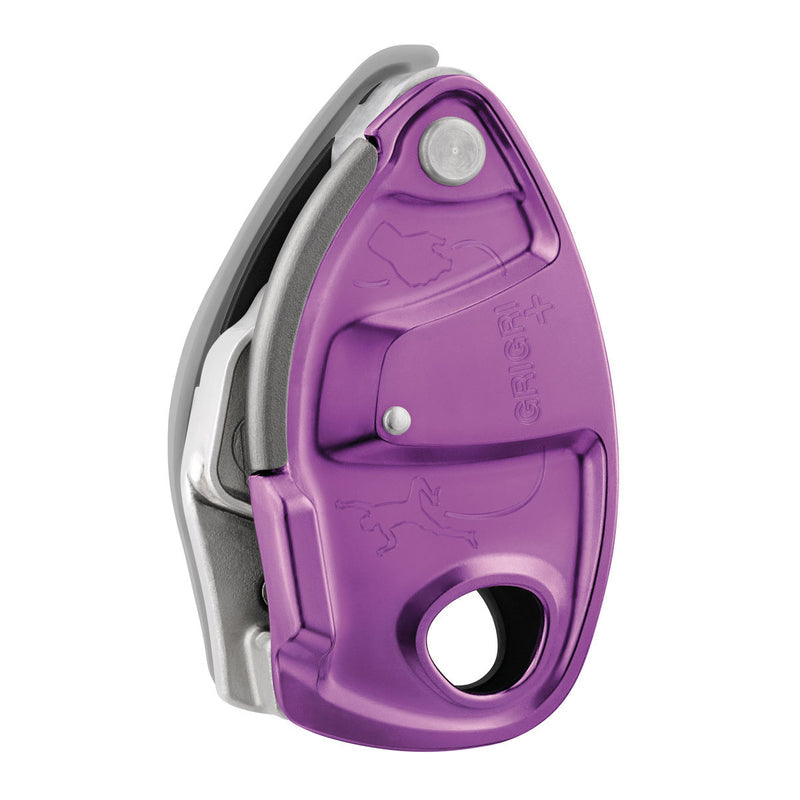

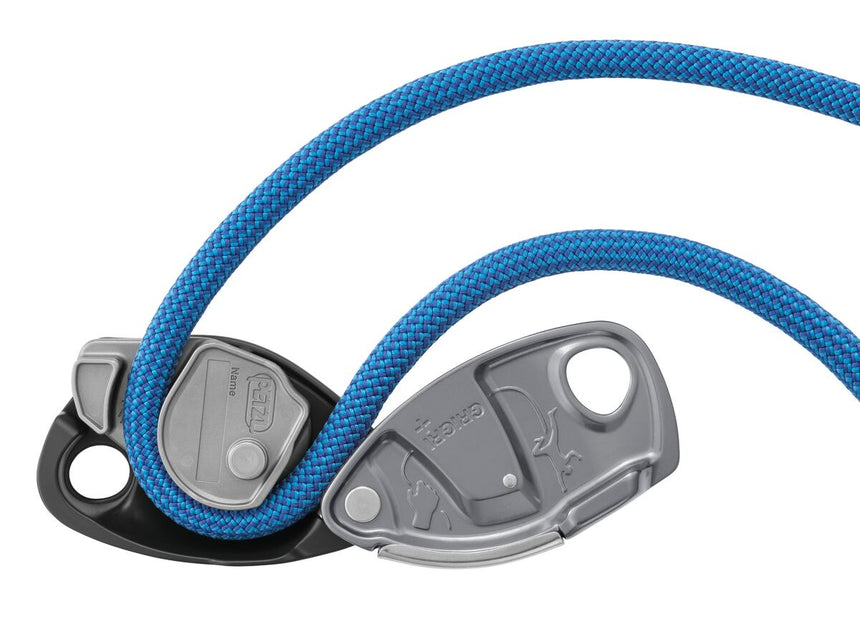

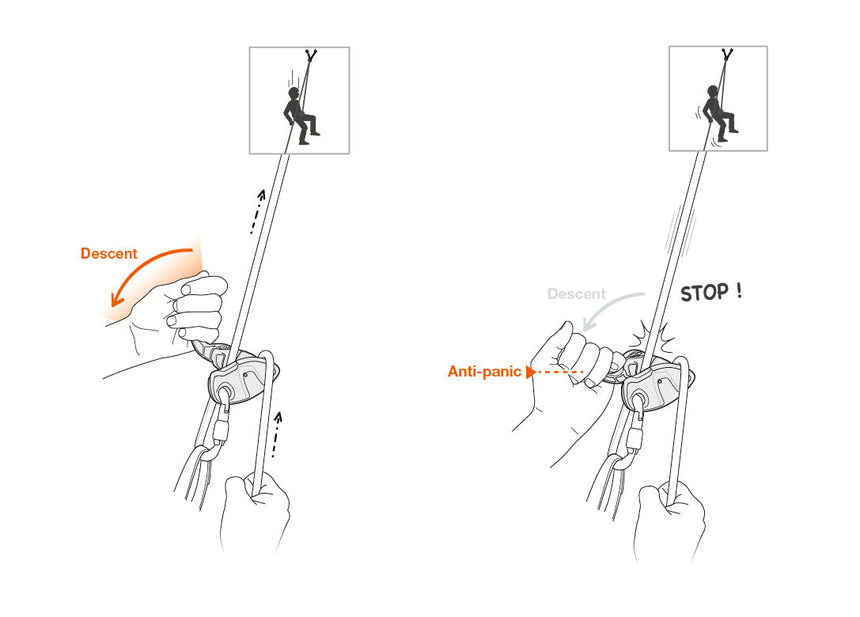

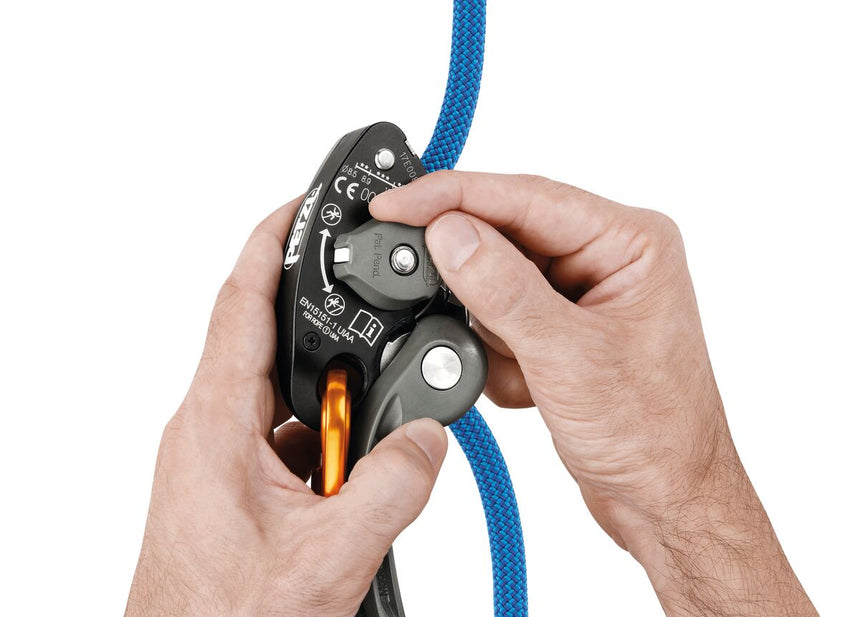

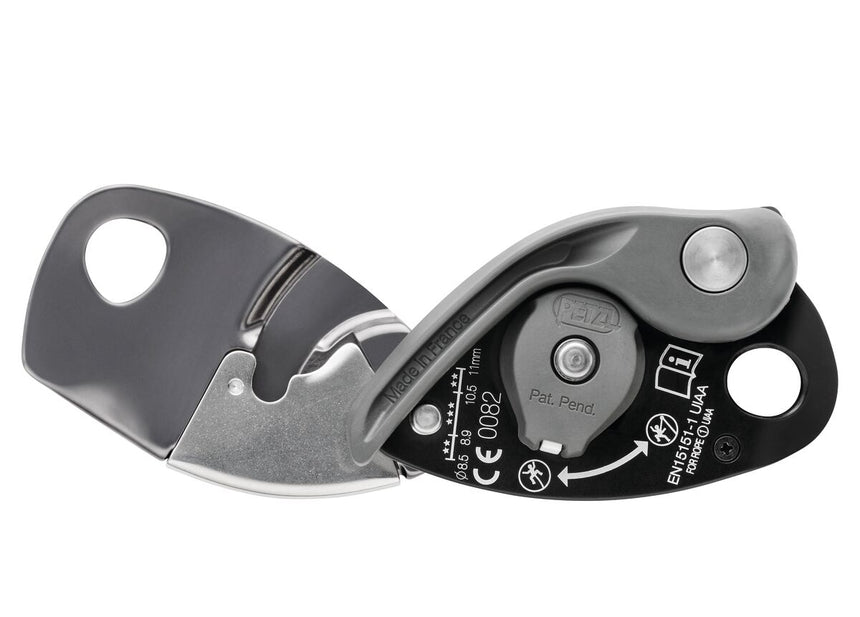

 Shipping
Shipping






